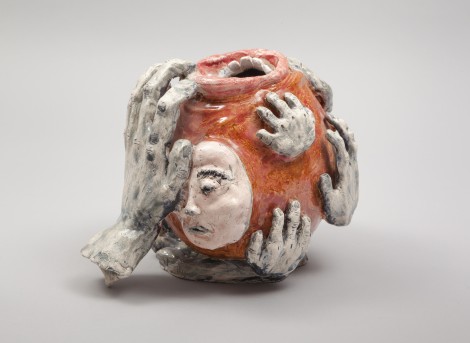The Special Exhibitions Hall on the third floor of the Gardiner Museum has been transformed into a remarkable sanctuary of hope. Commemorating the 10-year anniversary of the Gardiner’s partnership with the Barbra Schlifer Commemorative Clinic, Transformation By Fire: Women Overcoming Violence Through Clay is a powerful and moving exhibition that showcases works created by women who have suffered violence.
The Schlifer Clinic, in conjunction with the Gardiner Museum, provides a 12-week art therapy workshop for women, under the guidance of art therapist Suzanne Thomson and established sculptural ceramic artist Susan Low-Beer. At the end of each workshop, a small private exhibition is held for participants and their families in the lobby of the Gardiner. In order to mark the 10 years of healing that this workshop has facilitated since its foundation, chief curator Rachel Gotlieb decided to publicly display a number of works from the last decade.
“We wanted to show the world that we aren’t just a museum that shows beautiful objects, but we are very active in this socially responsible program,” Gotlieb explained during a recent interview with The Varsity.
The unconventional ceramic pieces are beautiful in their own way, although it is clear that they are expressions of incomprehensible horrors, coated with a thin veneer of glaze and paint. According to Gotlieb, the clay itself plays an important role in the restorative journey undertaken by the women who have participated in the clinic’s workshop. “The material itself grounds you, it’s very earthy,” she said. “And when you experience trauma, you often disassociate it from your body … so you have an out of mind, out of body experience.”
Clay is thought to be a medium that centres the mind, and it can often be a useful tool for trauma survivors to unearth and discover subconscious ideas and responses. Some of the workshop’s participants spoke to this very sentiment in a video accompanying the exhibit; the women featured in the video asserted that clay’s malleability and tactile properties helped them in the process of coming to terms with their past.
Many of the women were able to make connections with and find metaphors within the clay itself. Gotlieb explained that “the first connection was that [the clay] becomes fragile, and sometimes a lot of the women saw their work get broken or destroyed in the kiln, and they would bring it back together and assemble it, and they realized that’s what they were doing with their lives.”
The set up of the exhibit is simple; the pieces on display are laid out on low tables throughout the exhibit. “We didn’t want to overly fetishize the objects by putting them in vitrines,” Gotlieb explained. “But at the same time, we wanted to treat them with respect… So they’re arranged in such a way that they have almost a table-like effect.”
The layout of the gallery also invites the viewer to glimpse into the very private and personal struggle for healing. Divided into four sections — Metamorphosis and Transformation, Hope and Resilience, Mind and Body, and Sanctuary and Shelter — the exhibit echoes the prevailing themes found throughout the majority of the artwork produced by the workshop over the last decade.
“These women are very courageous, because [of] what they’re doing — the first component is art therapy, [but] the second component is social activism because they’re going public with their stories and narratives,” Gotlieb explained admiringly. This bravery is evident and honoured in every aspect of this exhibit, and particularly in its title. As Gotlieb explained, clay changes its molecular structure once fired in a kiln, rendering it immutable, hard, and strong — an apt analogy for women who have been through fire themselves and have become all the stronger because of it.
Although simmering with ugly truths, positivity and hope ring through the exhibition, staying true to the invitation posted at the entrance of the gallery: “Come walk our neighbourhood, your street, as we break the silence and shift our foundations from dark to light.”
Transformation By Fire runs at the Gardiner Museum until April 28, 2013. Admission is free.



